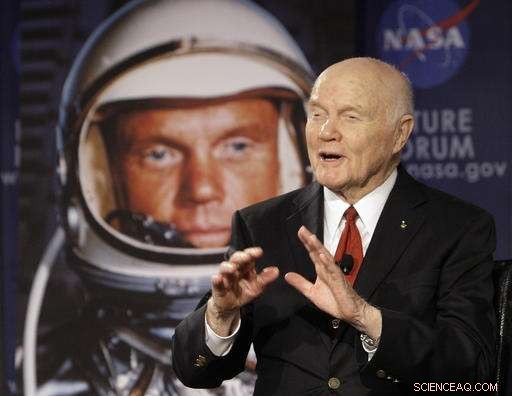
Neste 20 de fevereiro, 2012, foto do arquivo, O senador norte-americano John Glenn conversa com astronautas na Estação Espacial Internacional via satélite antes de uma discussão intitulada "Aprendendo com o passado para inovar para o futuro" em Columbus, Ohio. Glenn, que foi o primeiro astronauta dos EUA a orbitar a Terra e mais tarde passou 24 anos representando Ohio no Senado, morreu aos 95 anos. (AP Photo / Jay LaPrete, Arquivo)
John Glenn, cujo voo de 1962 como o primeiro astronauta dos EUA a orbitar a Terra o tornou um herói americano e o impulsionou a uma longa carreira no Senado dos EUA, morreu quinta-feira. O último sobrevivente dos astronautas originais do Mercury 7 tinha 95 anos.
Glenn morreu no James Cancer Hospital em Columbus, Ohio, onde ele ficou hospitalizado por mais de uma semana, disse Hank Wilson, diretor de comunicações da Escola de Relações Públicas John Glenn.
John Herschel Glenn Jr. teve duas carreiras importantes que muitas vezes se cruzaram:voo e política, e ele disparou em ambos.
Antes de ganhar fama orbitando o mundo, ele foi um piloto de caça em duas guerras, e como piloto de teste, ele estabeleceu um recorde de velocidade transcontinental. Mais tarde, ele serviu 24 anos no Senado de Ohio. Um raro revés foi uma candidatura fracassada em 1984 à indicação presidencial democrata.
Sua longa carreira política permitiu que ele voltasse ao espaço no ônibus espacial Discovery aos 77 anos em 1998, uma volta cósmica de vitória que ele apreciou e se transformou em um momento de aprendizado sobre envelhecer. Ele detém o recorde de pessoa mais velha no espaço.
Mais do que nada, Glenn foi o derradeiro e único herói espacial americano:um veterano de combate com um sorriso fácil, um forte casamento de 70 anos e nervos de aço. Escolas, um centro espacial e o aeroporto de Columbus foram nomeados em sua homenagem. As crianças também.
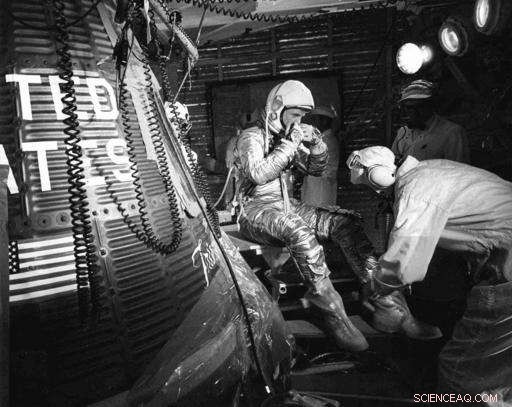
Neste 20 de fevereiro, 1962, foto do arquivo, o astronauta John Glenn está sentado ao lado da cápsula espacial Friendship 7 no topo de um foguete Atlas no Cabo Canaveral, Flórida, durante os preparativos para seu vôo, o que o tornou o primeiro americano a orbitar a Terra. Glenn, que mais tarde passou 24 anos representando Ohio no Senado, morreu aos 95 anos. (Foto / arquivo AP)
A União Soviética saltou à frente na exploração do espaço ao colocar o satélite Sputnik 1 em órbita em 1957, e então lançou o primeiro homem no espaço, cosmonauta Yuri Gagarin, em um voo orbital de 108 minutos em 12 de abril, 1961. Após dois voos suborbitais de Alan Shepard Jr. e Gus Grissom, cabia a Glenn ser o primeiro americano a orbitar a Terra.
"Boa Sorte Vá com Deus, John Glenn, "o astronauta Scott Carpenter comunicou-se pelo rádio pouco antes de Glenn disparar de uma plataforma de lançamento do Cabo Canaveral, agora um marco histórico nacional, para um lugar que a América nunca tinha estado. Na época daquele 20 de fevereiro, 1962, voo, Glenn tinha 40 anos.
Com a frase totalmente comercial, "Roger, o relógio está funcionando, estamos em andamento, "Glenn transmitiu um rádio para a Terra quando começou suas 4 horas, 55 minutos e 23 segundos no espaço. Anos depois, ele explicou que disse isso porque não sentia que havia decolado e era a única maneira pela qual sabia que havia decolado.
Durante o voo, Glenn proferiu uma frase que repetia com frequência ao longo da vida:"Zero G, e me sinto bem. "
"Ainda parece tão vívido para mim, "Glenn disse em uma entrevista à Associated Press em 2012 no 50º aniversário do vôo." Eu ainda posso pseudo sentir algumas das mesmas sensações que tive naquela época durante o lançamento e tudo. "
Glenn disse que frequentemente perguntavam se ele estava com medo, e ele respondeu, "Se você está falando sobre o medo que supera o que você deve fazer, não. Você treinou muito para esses voos. "

Neste 20 de fevereiro, Foto de 1962 disponibilizada pela NASA, o astronauta John Glenn pilota a espaçonave "Friendship 7" Mercury durante seu voo histórico como o primeiro americano a orbitar a Terra. Glenn, que mais tarde passou 24 anos representando Ohio no Senado, morreu aos 95 anos. (NASA via AP)
A viagem de Glenn na apertada cápsula Friendship 7 teve seus momentos assustadores, Contudo. Sensores mostraram que seu escudo térmico estava solto após três órbitas, e o Controle da Missão temia que ele pudesse queimar durante a reentrada quando as temperaturas atingissem 3, 000 graus. Mas o escudo térmico aguentou.
Mesmo antes disso, Glenn voou em céus perigosos. Ele foi um piloto de caça na Segunda Guerra Mundial e na Coréia que voou baixo, teve seu avião crivado de balas, voou com o grande jogador do beisebol Ted Williams e ganhou apelidos machistas durante 149 missões de combate. E como piloto de teste, ele quebrou recordes de aviação.
Os de olhos verdes, o fuzileiro naval telegênico ganhou até US $ 25, 000 no game show "Name That Tune" com um parceiro de 10 anos. E isso foi antes de 6 de abril, 1959, quando sua vida mudou ao ser selecionado como um dos astronautas do Mercury 7 e instantaneamente começou a atrair mais do que sua cota de holofotes.
Glenn nos anos posteriores regalou multidões com histórias de testes de aspirantes a astronautas da NASA, de testes psicológicos - vêm com 20 respostas para a pergunta aberta "Eu sou" - para sobreviver a um giro que empurrou 16 vezes a gravidade normal contra seu corpo, estourando os vasos sanguíneos.
Mas não foi tão ruim quanto vir ao Cabo Canaveral para ver o primeiro teste de foguete não tripulado.
"Estamos vendo essa coisa subir e subir e subir ... e de repente explodiu sobre nós, e essa foi a nossa introdução ao Atlas, "Glenn disse em 2011." Nós nos olhamos e queríamos ter uma reunião com os engenheiros pela manhã. "
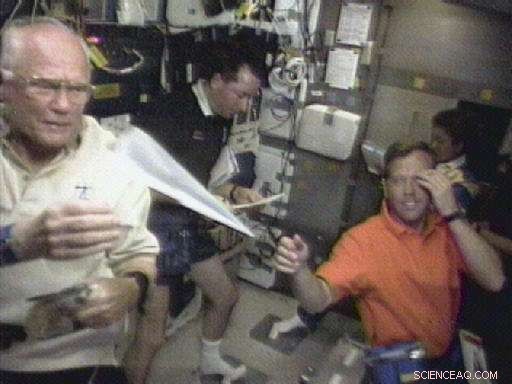
Neste domingo, 1 de novembro, Imagem de 1998 feita de vídeo, astronauta John Glenn, deixou, recupera um avião de papel para o piloto Steven Lindsey, primeiro plano à direita, no convés médio do ônibus espacial Discovery. Astronauta Stephen Robinson, fundo certo, e o astronauta japonês Chiaki Mukai examinam a papelada ao fundo. Glenn morreu quinta-feira, 8 de dezembro 2016, aos 95 anos de idade. (AP Photo / NASA, Arquivo)
Em 1959, Glenn escreveu na revista Life:"A viagem espacial está na fronteira da minha profissão. Vai ser realizada, e eu quero estar nisso. Há também um elemento de dever simples envolvido. Estou convencido de que tenho algo a oferecer a este projeto. "
Esse senso de dever foi instilado desde cedo. Glenn nasceu em 18 de julho, 1921, em Cambridge, Ohio, e cresceu em New Concord, Ohio, com o apelido "Bud". Ele se juntou à banda da cidade como trompetista aos 10 anos e acompanhou seu pai em um Memorial Day em uma versão ecoante de "Taps". Em suas memórias de 1999, Glenn escreveu "esse sentimento resume minha infância. Formou minhas crenças e meu senso de responsabilidade. Tudo o que veio depois disso veio naturalmente".
Seu amor por voar durou toda a vida; John Glenn Sênior falou sobre as muitas noites de verão em que chegou em casa e encontrou seu filho correndo pelo quintal com os braços estendidos, fingindo que estava pilotando um avião. Último Junho, em uma cerimônia que mudou o nome do aeroporto de Columbus para ele, Glenn se lembra de ter implorado aos pais que o levassem àquele aeroporto para ver os aviões sempre que passassem pela cidade:"Era algo que me fascinava." Ele pilotou seu próprio avião particular até os 90 anos.
O objetivo de Glenn de se tornar um piloto comercial foi mudado pela Segunda Guerra Mundial. Ele deixou Muskingum College para ingressar no Naval Air Corps e, logo depois, os fuzileiros navais.
Ele se tornou um piloto de caça de sucesso que executou 59 missões perigosas, frequentemente como voluntário ou como reserva solicitada de pilotos designados. Uma guerra depois, na Coreia, ele ganhou o apelido de "MiG-Mad Marine" (ou "Old Magnet A-, " which he sometimes paraphrased as "Old Magnet Tail.")
"I was the one who went in low and got them, " Glenn said, explaining that he often landed with huge holes in the side of his aircraft because he didn't like to shoot from high altitudes.
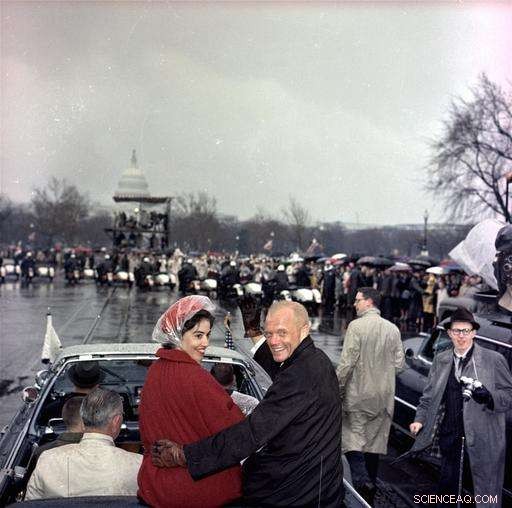
In this Feb. 26, 1962 file photo, Mercury astronaut John Glenn, and his wife, Annie, ride in the back of an open car with Vice-President Johnson during a parade in Glenn's honor in Washington. The Capitol is seen in the background. Glenn, the first American to orbit Earth who later spent 24 years representing Ohio in the Senate, died Thursday, Dec. 8, 2016, at the age of 95. (AP Photo/File)
Glenn's public life began when he broke the transcontinental airspeed record, bursting from Los Angeles to New York City in three hours, 23 minutes and 8 seconds. With his Crusader averaging 725 mph, the 1957 flight proved the jet could endure stress when pushed to maximum speeds over long distances.
In New York, he got a hero's welcome—his first tickertape parade. He got another after his flight on Friendship 7.
That mission also introduced Glenn to politics. He addressed a joint session of Congress, and dined at the White House. He became friends with President Kennedy and ally and friend of his brother Robert. The Kennedys urged him to enter politics, and after a difficult few starts he did.
Glenn spent 24 years in the U.S. Senate, representing Ohio longer than any other senator in the state's history. He announced his impending retirement in 1997, 35 years to the day after he became the first American in orbit, dizendo, "There is still no cure for the common birthday."
Glenn returned to space in a long-awaited second flight in 1998 aboard the space shuttle Discovery. He got to move around aboard the shuttle for far longer—nine days compared with just under five hours in 1962—as well as sleep and experiment with bubbles in weightlessness.
In a news conference from space, Glenn said, "To look out at this kind of creation out here and not believe in God is to me impossible."
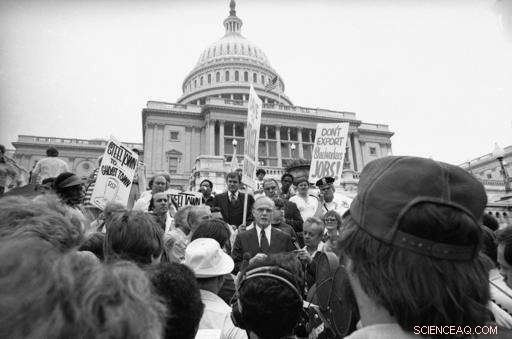
Nesta sexta-feira, 23 de setembro, 1977 file photo, Sen. John Glenn, D-Ohio, Centro, speaks to a group of Youngstown, Ohio Steelworkers on the steps of the Capitol in Washington. The group urged the government to curb steel imports and to relax pollution control requirements. Glenn, the first U.S. astronaut to orbit Earth who later spent 24 years representing Ohio in the Senate, died Thursday, Dec. 8, 2016, at the age of 95. (AP Photo/Harvey Georges, Arquivo)
NASA tailored a series of geriatric-reaction experiments to create a scientific purpose for Glenn's mission, but there was more to it than that:a revival of the excitement of the earliest days of the space race, a public relations bonanza and the gift of a lifetime.
"America owed John Glenn a second flight, " NASA Administrator Dan Goldin said.
Glenn would later write that when he mentioned the idea of going back into space to his wife, Annie, she responded:"Over my dead body."
Glenn and his crewmates flew 3.6 million miles, compared with 75, 000 miles aboard Friendship 7.
Shortly before he ran for the 1984 Democratic presidential nomination, a new generation was introduced to astronaut Glenn with the film adaptation of Tom Wolfe's book "The Right Stuff." He was portrayed as the ultimate straight arrow amid a group of hard-partying astronauts.
Glenn said in 2011:"I don't think any of us cared for the movie 'The Right Stuff'; I know I didn't."
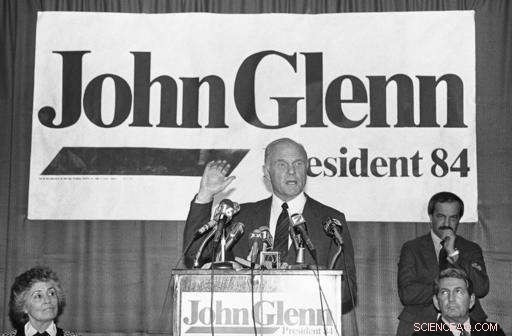
Nesta terça, Jan. 18, 1984 file photo, Sen. John Glenn, D-Ohio, answers questions from the press in Jackson, Miss. At left is his wife, Annie Glenn. Glenn travelled through the South seeking support for his presidential campaign. Glenn, the first U.S. astronaut to orbit Earth who later spent 24 years representing Ohio in the Senate, died Thursday, Dec. 8, 2016, at the age of 95. (AP Photo/Tannen Maury, Arquivo)
Glenn was unable to capitalize on the publicity, no entanto, and his poorly organized campaign was short-lived. He dropped out of the race with his campaign $2.5 million in the red—a debt that lingered even after he retired from the Senate in 1999.
He later joked that except for going into debt, humiliating his family and gaining 16 pounds, running for president was a good experience.
Glenn generally steered clear of campaigns after that, saying he didn't want to mix politics with his second space flight. He sat out the Senate race to succeed him—he was hundreds of miles above Earth on Election Day—and largely was quiet in the 2000 presidential race.
He first ran for the Senate in 1964 but left the race when he suffered a concussion after slipping in the bathroom and hitting his head on the tub.
He tried again in 1970 but was defeated in the primary by Howard Metzenbaum, who later lost the general election to Robert Taft Jr. It was the start of a complex relationship with Metzenbaum, whom he later joined in the Senate.
For the next four years, Glenn devoted his attention to business and investments that made him a multimillionaire. He had joined the board of Royal Crown Cola after the aborted 1964 campaign and was president of Royal Crown International from 1967 to 1969. In the early 1970s, he remained with Royal Crown and invested in a chain of Holiday Inns.
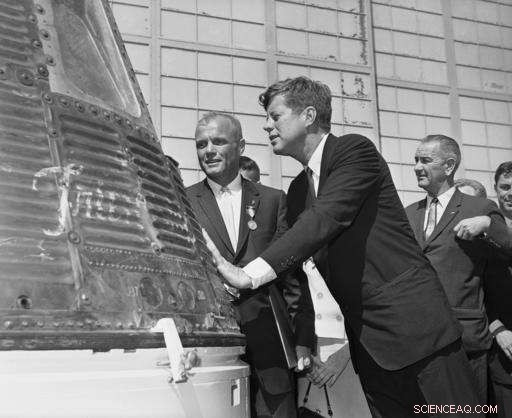
In this Feb. 23, 1962 file photo, astronaut John Glenn and President John F. Kennedy inspect the Friendship 7, the Mercury capsule in which Glenn became the first American to orbit the Earth. Kennedy presented Distinguished Service medal to Glenn at Cape Canaveral, Fla. At right is Vice President Lyndon Johnson. Glenn, who later spent 24 years representing Ohio in the Senate, has died at 95. (AP Photo/Vincent P. Connolly, Arquivo)
In 1974, Glenn ran against Metzenbaum in what turned into a bitter primary and won the election. He eventually made peace with Metzenbaum, who won election to the Senate in 1976.
Glenn set a record in 1980 by winning re-election with a 1.6 million vote margin.
He became an expert on nuclear weaponry and was the Senate's most dogged advocate of nonproliferation. He was the leading supporter of the B-1 bomber when many in Congress doubted the need for it. As chairman of the Governmental Affairs Committee, he turned a microscope on waste and fraud in the federal bureaucracy.
Glenn said the lowest point of his life was 1990, when he and four other senators came under scrutiny for their connections to Charles Keating, the notorious financier who eventually served prison time for his role in the costly savings and loan failure of the 1980s. The Senate Ethics Committee cleared Glenn of serious wrongdoing but said he "exercised poor judgment."
The episode was the only brush with scandal in his long public career and didn't diminish his popularity in Ohio.
Glenn joked that the only astronaut he was envious of was his fellow Ohioan:Neil Armstrong, the first man to walk on the moon.
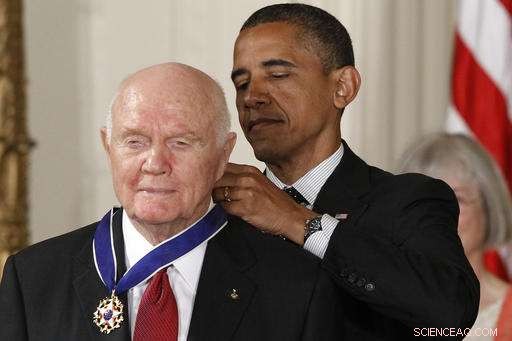
Nesta terça, May 29, 2012, foto do arquivo, President Barack Obama awards the Medal of Freedom to former astronaut John Glenn during a ceremony in the East Room of the White House in Washington. Glenn, the first American to orbit Earth who later spent 24 years representing Ohio in the Senate, died Thursday, Dec. 8, 2016, at the age of 95. (AP Photo/Charles Dharapak, Arquivo)
"I've been very fortunate to have a lot of great experiences in my life and I'm thankful for them, " he said in 2012.
In 1943, Glenn married his childhood sweetheart, Anna Margaret Castor. They met when they were toddlers, and when she had mumps as a teenager, he came to her house, cut a hole in her bedroom window screen, and passed her a radio to keep her company, a friend recounted.
"I don't remember the first time I told Annie I loved her, or the first time she told me, " Glenn would write in his memoir. "It was just something we both knew." He bought her a diamond engagement ring in 1942 for $125. It's never been replaced.
They had two children, Carolyn and John David.
He and his wife, Annie, split their later years between Washington and Columbus. Both served as trustees at their alma mater, Muskingum College. Glenn spent time promoting the John Glenn School of Public Affairs at Ohio State University, which also houses an archive of his private papers and photographs.
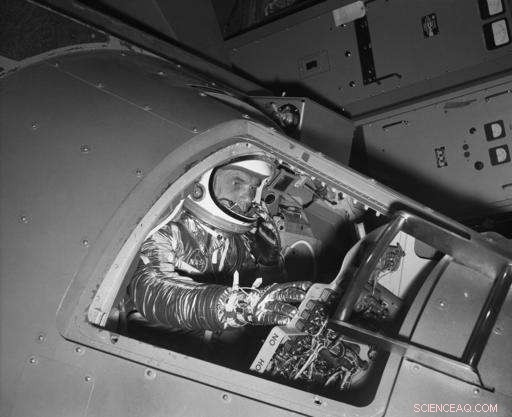
In this Jan. 11, 1961 file photo, Marine Lt. Col. John Glenn reaches for controls inside a Mercury capsule procedures trainer as he shows how the first U.S. astronaut will ride through space during a demonstration at the National Aeronautics and Space Administration Research Center in Langley Field, Va. Glenn, the first American to orbit Earth who later spent 24 years representing Ohio in the Senate, died Thursday, Dec. 8, 2016, at the age of 95. (AP Photo/File)
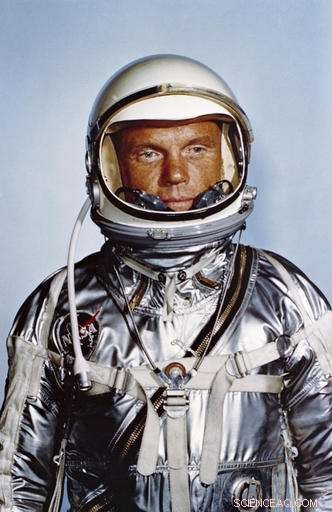
This undated photo made available by NASA shows astronaut John Glenn in his Mercury flight suit. Glenn, the first American to orbit Earth who later spent 24 years representing Ohio in the Senate, died Thursday, Dec. 8, 2016, at the age of 95. (NASA via AP)
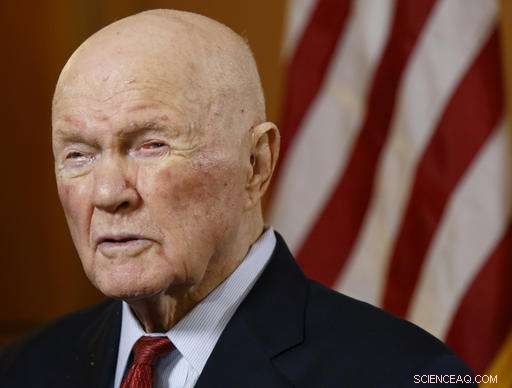
In this May 14, 2015 file photo, former astronaut and senator John Glenn answers questions during an interview at the Ohio Statehouse. Glenn died Thursday, Dec. 8, 2016, at the age of 95. (AP Photo/Paul Vernon, Arquivo)
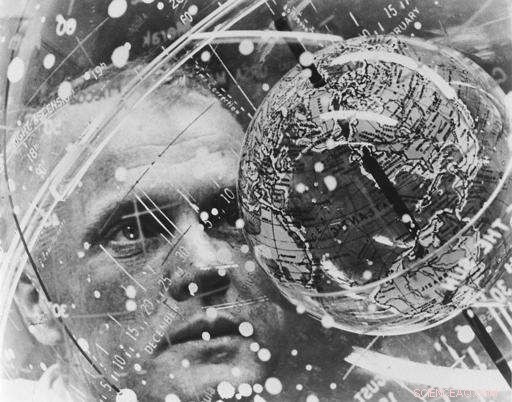
In this February 1962 photo made available by NASA, astronaut John Glenn looks into a Celestial Training Device globe at the Aeromedical Laboratory at Cape Canaveral, Fla. Glenn, the first American to orbit Earth who later spent 24 years representing Ohio in the Senate, died Thursday, Dec. 8, 2016, at the age of 95. (NASA via AP)
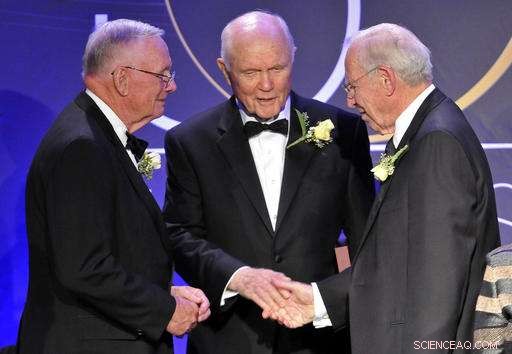
Nesta sexta-feira, 29 de agosto 2008 file photo, astronauts Neil Armstrong, deixou, the first man to walk on the moon, John Glenn Jr., Centro, the first American to orbit earth, and James Lovell, direito, commander of Apollo 13, stand at a gathering of 19 of the astronauts who call Ohio home in Cleveland. The gathering of Ohio astronauts was part of NASA's 50th Anniversary celebration. Glenn died Thursday, Dec. 8, 2016, at the age of 95. (AP Photo/Jason Miller, Arquivo)
© 2016 Associated Press. Todos os direitos reservados.